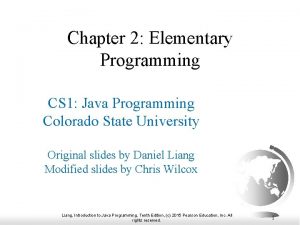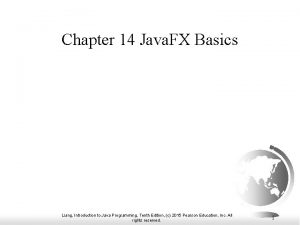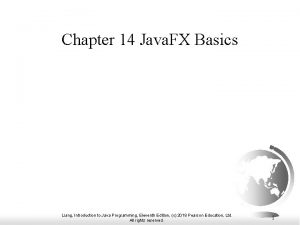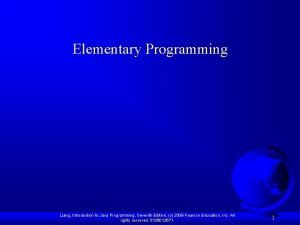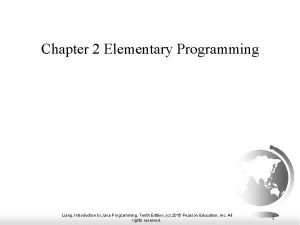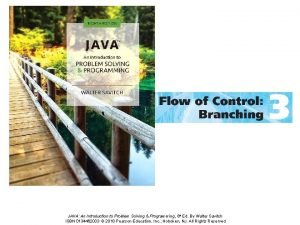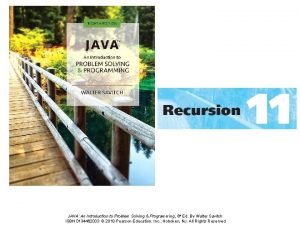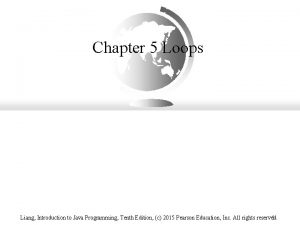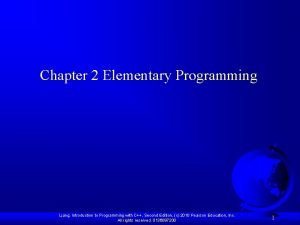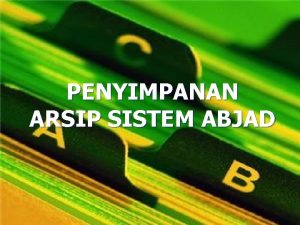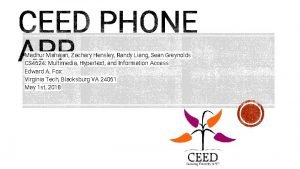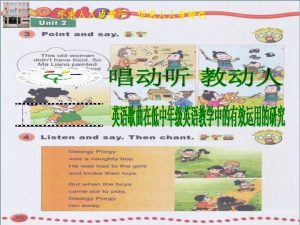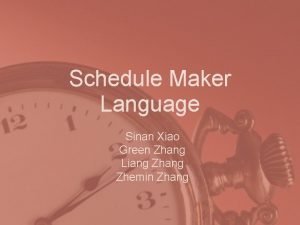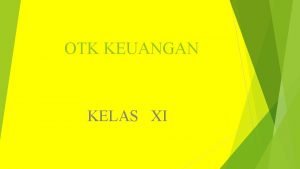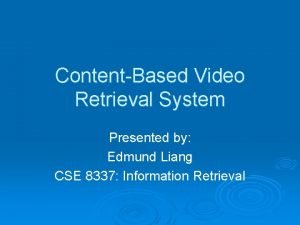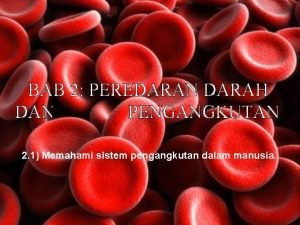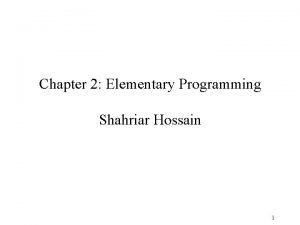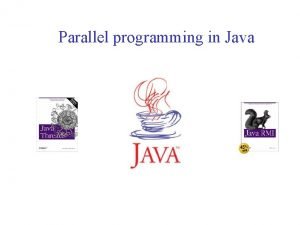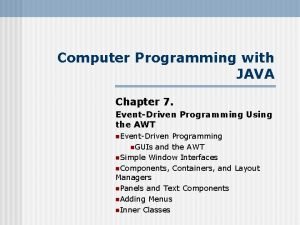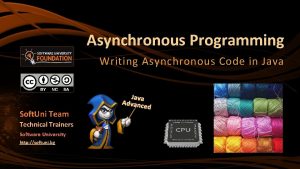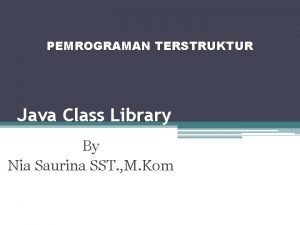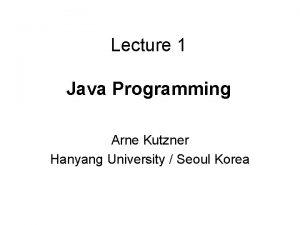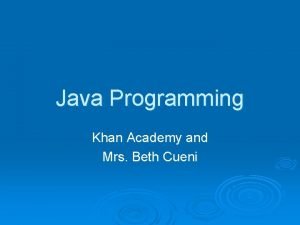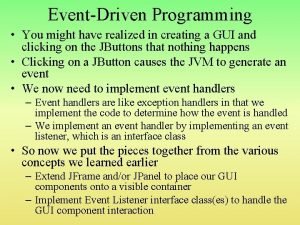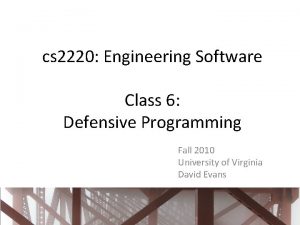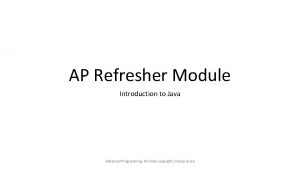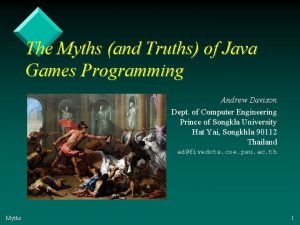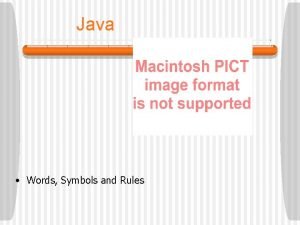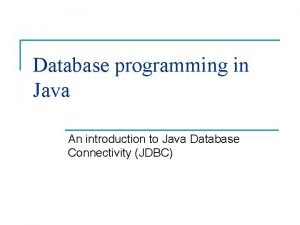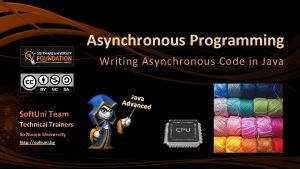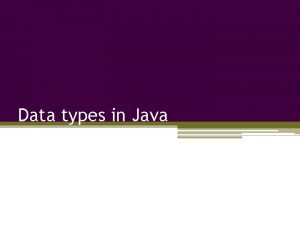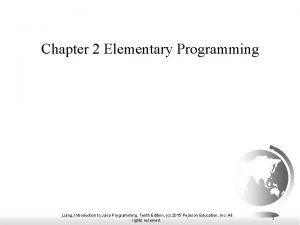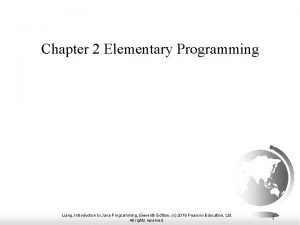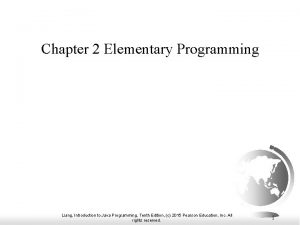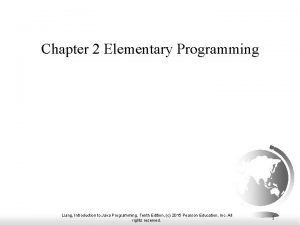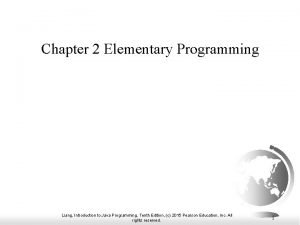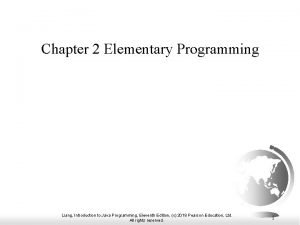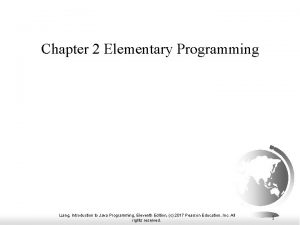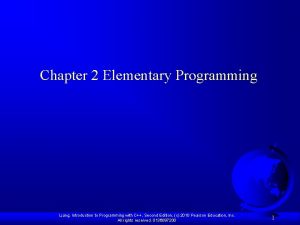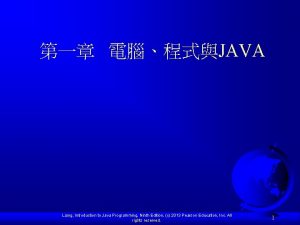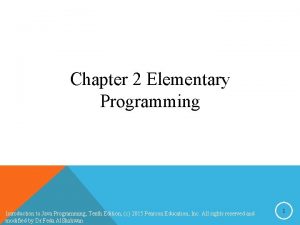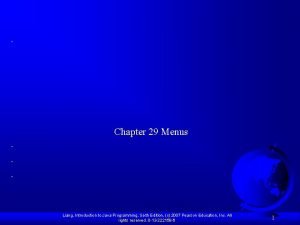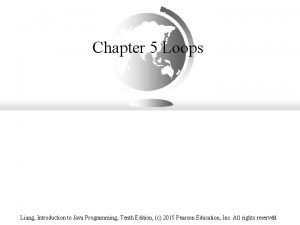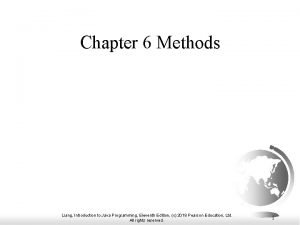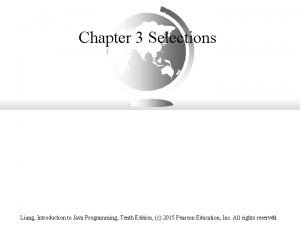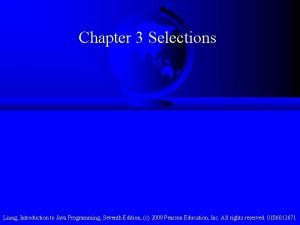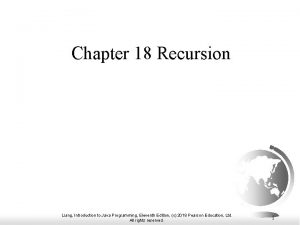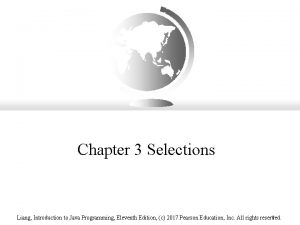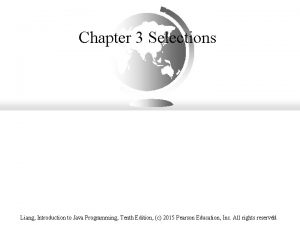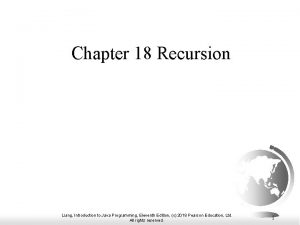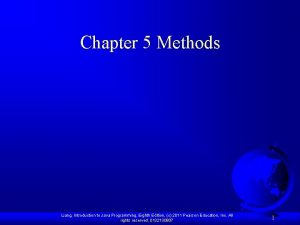Chapter 2 Elementary Programming Liang Introduction to Java





























































- Slides: 61

Chapter 2 Elementary Programming Liang, Introduction to Java Programming, Seventh Edition, (c) 2009 Pearson Education, Inc. All rights reserved. 0136012671 1

Motivations In the preceding chapter, you learned how to create, compile, and run a Java program. Starting from this chapter, you will learn how to solve practical problems programmatically. Through these problems, you will learn Java primitive data types and related subjects, such as variables, constants, data types, operators, expressions, and input and output. Liang, Introduction to Java Programming, Seventh Edition, (c) 2009 Pearson Education, Inc. All rights reserved. 0136012671 2

Objectives F F F F To write Java programs to perform simple calculations (§ 2. 2). To use identifiers to name variables, constants, methods, and classes (§ 2. 3). To use variables to store data (§§ 2. 4 -2. 5). To program with assignment statements and assignment expressions (§ 2. 5). To use constants to store permanent data (§ 2. 6). To declare Java primitive data types: byte, short, int, long, float, double, and char (§§ 2. 7 – 2. 9). To use Java operators to write numeric expressions (§§ 2. 7– 2. 8). To represent characters using the char type (§ 2. 9). To represent a string using the String type (§ 2. 10). To obtain input from the console using the Scanner class (§§ 2. 11 -2. 12). To become familiar with Java documentation, programming style, and naming conventions (§ 2. 13). To distinguish syntax errors, runtime errors, and logic errors (§ 2. 14). To debug logic errors (§ 2. 15). (GUI) To obtain input using the JOption. Pane input dialog boxes (§ 2. 16). Liang, Introduction to Java Programming, Seventh Edition, (c) 2009 Pearson Education, Inc. All rights reserved. 0136012671 3

Introducing Programming with an Example Listing 2. 1 Computing the Area of a Circle This program computes the area of the circle. Compute. Area Run Liang, Introduction to Java Programming, Seventh Edition, (c) 2009 Pearson Education, Inc. All rights reserved. 0136012671 4

animation Trace a Program Execution public class Compute. Area { /** Main method */ public static void main(String[] args) { double radius; double area; allocate memory for radius no value // Assign a radius = 20; // Compute area = radius * 3. 14159; // Display results System. out. println("The area for the circle of radius " + radius + " is " + area); } } Liang, Introduction to Java Programming, Seventh Edition, (c) 2009 Pearson Education, Inc. All rights reserved. 0136012671 5

animation Trace a Program Execution public class Compute. Area { /** Main method */ public static void main(String[] args) { double radius; double area; // Assign a radius = 20; // Compute area = radius * 3. 14159; memory radius no value area no value allocate memory for area // Display results System. out. println("The area for the circle of radius " + radius + " is " + area); } } Liang, Introduction to Java Programming, Seventh Edition, (c) 2009 Pearson Education, Inc. All rights reserved. 0136012671 6

animation Trace a Program Execution public class Compute. Area { /** Main method */ public static void main(String[] args) { double radius; double area; assign 20 to radius area 20 no value // Assign a radius = 20; // Compute area = radius * 3. 14159; // Display results System. out. println("The area for the circle of radius " + radius + " is " + area); } } Liang, Introduction to Java Programming, Seventh Edition, (c) 2009 Pearson Education, Inc. All rights reserved. 0136012671 7

animation Trace a Program Execution public class Compute. Area { /** Main method */ public static void main(String[] args) { double radius; double area; memory radius area 20 1256. 636 // Assign a radius = 20; // Compute area = radius * 3. 14159; compute area and assign it to variable area // Display results System. out. println("The area for the circle of radius " + radius + " is " + area); } } Liang, Introduction to Java Programming, Seventh Edition, (c) 2009 Pearson Education, Inc. All rights reserved. 0136012671 8

animation Trace a Program Execution public class Compute. Area { /** Main method */ public static void main(String[] args) { double radius; double area; memory radius area 20 1256. 636 // Assign a radius = 20; // Compute area = radius * 3. 14159; print a message to the console // Display results System. out. println("The area for the circle of radius " + radius + " is " + area); } } Liang, Introduction to Java Programming, Seventh Edition, (c) 2009 Pearson Education, Inc. All rights reserved. 0136012671 9

Identifiers An identifier is a sequence of characters that consist of letters, digits, underscores (_), and dollar signs ($). F An identifier must start with a letter, an underscore (_), or a dollar sign ($). It cannot start with a digit. F – An identifier cannot be a reserved word. (See Appendix A, “Java Keywords, ” for a list of reserved words). F An identifier cannot be true, false, or null. F An identifier can be of any length. Liang, Introduction to Java Programming, Seventh Edition, (c) 2009 Pearson Education, Inc. All rights reserved. 0136012671 10

Variables // Compute the first area radius = 1. 0; area = radius * 3. 14159; System. out. println("The area is “ + area + " for radius "+radius); // Compute the second area radius = 2. 0; area = radius * 3. 14159; System. out. println("The area is “ + area + " for radius "+radius); Liang, Introduction to Java Programming, Seventh Edition, (c) 2009 Pearson Education, Inc. All rights reserved. 0136012671 11

Declaring Variables int x; // Declare x to be an // integer variable; double radius; // Declare radius to // be a double variable; char a; // Declare a to be a // character variable; Liang, Introduction to Java Programming, Seventh Edition, (c) 2009 Pearson Education, Inc. All rights reserved. 0136012671 12

Assignment Statements x = 1; // Assign 1 to x; radius = 1. 0; // Assign 1. 0 to radius; a = 'A'; // Assign 'A' to a; Liang, Introduction to Java Programming, Seventh Edition, (c) 2009 Pearson Education, Inc. All rights reserved. 0136012671 13

Declaring and Initializing in One Step F int x = 1; F double d = 1. 4; Liang, Introduction to Java Programming, Seventh Edition, (c) 2009 Pearson Education, Inc. All rights reserved. 0136012671 14

Constants final datatype CONSTANTNAME = VALUE; final double PI = 3. 14159; final int SIZE = 3; Liang, Introduction to Java Programming, Seventh Edition, (c) 2009 Pearson Education, Inc. All rights reserved. 0136012671 15

Numerical Data Types Liang, Introduction to Java Programming, Seventh Edition, (c) 2009 Pearson Education, Inc. All rights reserved. 0136012671 16

TIP An excellent tool to demonstrate how numbers are stored in a computer was developed by Richard Rasala. You can access it at http: //www. ccs. neu. edu/jpt_2_3/bitdisplay/applet. htm Liang, Introduction to Java Programming, Seventh Edition, (c) 2009 Pearson Education, Inc. All rights reserved. 0136012671 17

Numeric Operators Liang, Introduction to Java Programming, Seventh Edition, (c) 2009 Pearson Education, Inc. All rights reserved. 0136012671 18

Integer Division +, -, *, /, and % 5 / 2 yields an integer 2. 5. 0 / 2 yields a double value 2. 5 5 % 2 yields 1 (the remainder of the division) Liang, Introduction to Java Programming, Seventh Edition, (c) 2009 Pearson Education, Inc. All rights reserved. 0136012671 19

Remainder Operator Remainder is very useful in programming. For example, an even number % 2 is always 0 and an odd number % 2 is always 1. So you can use this property to determine whether a number is even or odd. Suppose today is Saturday and your friends are going to meet in 10 days. What day is in 10 days? You can find that day is Tuesday using the following expression: Liang, Introduction to Java Programming, Seventh Edition, (c) 2009 Pearson Education, Inc. All rights reserved. 0136012671 20

Problem: Displaying Time Write a program that obtains hours and minutes from seconds. Display. Time Run Liang, Introduction to Java Programming, Seventh Edition, (c) 2009 Pearson Education, Inc. All rights reserved. 0136012671 21

Number Literals A literal is a constant value that appears directly in the program. For example, 34, 1, 000, and 5. 0 are literals in the following statements: int i = 34; long x = 1000000; double d = 5. 0; Liang, Introduction to Java Programming, Seventh Edition, (c) 2009 Pearson Education, Inc. All rights reserved. 0136012671 22

Integer Literals An integer literal can be assigned to an integer variable as long as it can fit into the variable. A compilation error would occur if the literal were too large for the variable to hold. For example, the statement byte b = 1000 would cause a compilation error, because 1000 cannot be stored in a variable of the byte type. An integer literal is assumed to be of the int type, whose value is between -231 (-2147483648) to 231– 1 (2147483647). To denote an integer literal of the long type, append it with the letter L or l. L is preferred because l (lowercase L) can easily be confused with 1 (the digit one). Liang, Introduction to Java Programming, Seventh Edition, (c) 2009 Pearson Education, Inc. All rights reserved. 0136012671 23

Floating-Point Literals Floating-point literals are written with a decimal point. By default, a floating-point literal is treated as a double type value. For example, 5. 0 is considered a double value, not a float value. You can make a number a float by appending the letter f or F, and make a number a double by appending the letter d or D. For example, you can use 100. 2 f or 100. 2 F for a float number, and 100. 2 d or 100. 2 D for a double number. Liang, Introduction to Java Programming, Seventh Edition, (c) 2009 Pearson Education, Inc. All rights reserved. 0136012671 24

Scientific Notation Floating-point literals can also be specified in scientific notation, for example, 1. 23456 e+2, same as 1. 23456 e 2, is equivalent to 123. 456, and 1. 23456 e-2 is equivalent to 0. 0123456. E (or e) represents an exponent and it can be either in lowercase or uppercase. Liang, Introduction to Java Programming, Seventh Edition, (c) 2009 Pearson Education, Inc. All rights reserved. 0136012671 25

Arithmetic Expressions is translated to (3+4*x)/5 – 10*(y-5)*(a+b+c)/x + 9*(4/x + (9+x)/y) Liang, Introduction to Java Programming, Seventh Edition, (c) 2009 Pearson Education, Inc. All rights reserved. 0136012671 26

How to Evaluate an Expression Though Java has its own way to evaluate an expression behind the scene, the result of a Java expression and its corresponding arithmetic expression are the same. Therefore, you can safely apply the arithmetic rule for evaluating a Java expression. Liang, Introduction to Java Programming, Seventh Edition, (c) 2009 Pearson Education, Inc. All rights reserved. 0136012671 27

Problem: Converting Temperatures Write a program that converts a Fahrenheit degree to Celsius using the formula: Fahrenheit. To. Celsius Run Liang, Introduction to Java Programming, Seventh Edition, (c) 2009 Pearson Education, Inc. All rights reserved. 0136012671 28

Shortcut Assignment Operators Operator Example Equivalent += i += 8 i = i + 8 -= f -= 8. 0 f = f - 8. 0 *= i *= 8 i = i * 8 /= i /= 8 i = i / 8 %= i %= 8 i = i % 8 Liang, Introduction to Java Programming, Seventh Edition, (c) 2009 Pearson Education, Inc. All rights reserved. 0136012671 29

Increment and Decrement Operators Operator ++var Name preincrement var++ postincrement --var predecrement var-- postdecrement Description The expression (++var) increments var by 1 and evaluates to the new value in var after the increment. The expression (var++) evaluates to the original value in var and increments var by 1. The expression (--var) decrements var by 1 and evaluates to the new value in var after the decrement. The expression (var--) evaluates to the original value in var and decrements var by 1. Liang, Introduction to Java Programming, Seventh Edition, (c) 2009 Pearson Education, Inc. All rights reserved. 0136012671 30

Increment and Decrement Operators, cont. Liang, Introduction to Java Programming, Seventh Edition, (c) 2009 Pearson Education, Inc. All rights reserved. 0136012671 31

Numeric Type Conversion Consider the following statements: byte i = 100; long k = i * 3 + 4; double d = i * 3. 1 + k / 2; Liang, Introduction to Java Programming, Seventh Edition, (c) 2009 Pearson Education, Inc. All rights reserved. 0136012671 32

Conversion Rules When performing a binary operation involving two operands of different types, Java automatically converts the operand based on the following rules: 1. 2. 3. 4. If one of the operands is double, the other is converted into double. Otherwise, if one of the operands is float, the other is converted into float. Otherwise, if one of the operands is long, the other is converted into long. Otherwise, both operands are converted into int. Liang, Introduction to Java Programming, Seventh Edition, (c) 2009 Pearson Education, Inc. All rights reserved. 0136012671 33

Type Casting Implicit casting double d = 3; (type widening) Explicit casting int i = (int)3. 0; (type narrowing) int i = (int)3. 9; (Fraction part is truncated) What is wrong? int x = 5 / 2. 0; Liang, Introduction to Java Programming, Seventh Edition, (c) 2009 Pearson Education, Inc. All rights reserved. 0136012671 34

Problem: Keeping Two Digits After Decimal Points Write a program that displays the sales tax with two digits after the decimal point. Sales. Tax Run Liang, Introduction to Java Programming, Seventh Edition, (c) 2009 Pearson Education, Inc. All rights reserved. 0136012671 35

Character Data Type char letter = 'A'; (ASCII) char num. Char = '4'; (ASCII) Four hexadecimal digits. char letter = 'u 0041'; (Unicode) char num. Char = 'u 0034'; (Unicode) NOTE: The increment and decrement operators can also be used on char variables to get the next or preceding Unicode character. For example, the following statements display character b. char ch = 'a'; System. out. println(++ch); Liang, Introduction to Java Programming, Seventh Edition, (c) 2009 Pearson Education, Inc. All rights reserved. 0136012671 36

Unicode Format Java characters use Unicode, a 16 -bit encoding scheme established by the Unicode Consortium to support the interchange, processing, and display of written texts in the world’s diverse languages. Unicode takes two bytes, preceded by u, expressed in four hexadecimal numbers that run from 'u 0000' to 'u. FFFF'. So, Unicode can represent 65535 + 1 characters. Unicode u 03 b 1 u 03 b 2 u 03 b 3 for three Greek letters Liang, Introduction to Java Programming, Seventh Edition, (c) 2009 Pearson Education, Inc. All rights reserved. 0136012671 37

Problem: Displaying Unicodes Write a program that displays two Chinese characters and three Greek letters. Display. Unicode Run Liang, Introduction to Java Programming, Seventh Edition, (c) 2009 Pearson Education, Inc. All rights reserved. 0136012671 38

Escape Sequences for Special Characters Description Escape Sequence Unicode Backspace b u 0008 Tab t u 0009 Linefeed n u 000 A Carriage return r u 000 D Backslash \ u 005 C Single Quote ' u 0027 Double Quote " u 0022 Liang, Introduction to Java Programming, Seventh Edition, (c) 2009 Pearson Education, Inc. All rights reserved. 0136012671 39

Appendix B: ASCII Character Set is a subset of the Unicode from u 0000 to u 007 f Liang, Introduction to Java Programming, Seventh Edition, (c) 2009 Pearson Education, Inc. All rights reserved. 0136012671 40

ASCII Character Set, cont. ASCII Character Set is a subset of the Unicode from u 0000 to u 007 f Liang, Introduction to Java Programming, Seventh Edition, (c) 2009 Pearson Education, Inc. All rights reserved. 0136012671 41

Casting between char and Numeric Types int i = 'a'; // Same as int i = (int)'a'; char c = 97; // Same as char c = (char)97; Liang, Introduction to Java Programming, Seventh Edition, (c) 2009 Pearson Education, Inc. All rights reserved. 0136012671 42

The String Type The char type only represents one character. To represent a string of characters, use the data type called String. For example, String message = "Welcome to Java"; String is actually a predefined class in the Java library just like the System class and JOption. Pane class. The String type is not a primitive type. It is known as a reference type. Any Java class can be used as a reference type for a variable. Reference data types will be thoroughly discussed in Chapter 7, “Objects and Classes. ” For the time being, you just need to know how to declare a String variable, how to assign a string to the variable, and how to concatenate strings. Liang, Introduction to Java Programming, Seventh Edition, (c) 2009 Pearson Education, Inc. All rights reserved. 0136012671 43

String Concatenation // Three strings are concatenated String message = "Welcome " + "to " + "Java"; // String Chapter is concatenated with number 2 String s = "Chapter" + 2; // s becomes Chapter 2 // String Supplement is concatenated with character B String s 1 = "Supplement" + 'B'; // s becomes Supplement. B Liang, Introduction to Java Programming, Seventh Edition, (c) 2009 Pearson Education, Inc. All rights reserved. 0136012671 44

Getting Input Using Scanner 1. Create a Scanner object Scanner scanner = new Scanner(System. in); 2. Use the methods next(), next. Byte(), next. Short(), next. Int(), next. Long(), next. Float(), next. Double(), or next. Boolean() to obtain to a string, byte, short, int, long, float, double, or boolean value. For example, System. out. print("Enter a double value: "); Scanner scanner = new Scanner(System. in); double d = scanner. next. Double(); Test. Scanner Liang, Introduction to Java Programming, Seventh Edition, (c) 2009 Pearson Education, Inc. All rights reserved. 0136012671 Run 45

Problem: Computing Loan Payments This program lets the user enter the interest rate, number of years, and loan amount and computes monthly payment and total payment. Compute. Loan Run Liang, Introduction to Java Programming, Seventh Edition, (c) 2009 Pearson Education, Inc. All rights reserved. 0136012671 46

Problem: Monetary Units This program lets the user enter the amount in decimal representing dollars and cents and output a report listing the monetary equivalent in single dollars, quarters, dimes, nickels, and pennies. Your program should report maximum number of dollars, then the maximum number of quarters, and so on, in this order. Compute. Change Liang, Introduction to Java Programming, Seventh Edition, (c) 2009 Pearson Education, Inc. All rights reserved. 0136012671 Run 47

Trace Compute. Change Suppose amount is 11. 56 int remaining. Amount = (int)(amount * 100); // Find the number of one dollars int number. Of. One. Dollars = remaining. Amount / 100; remaining. Amount = remaining. Amount % 100; remaining. Amount 1156 remaining. Amount initialized // Find the number of quarters in the remaining amount int number. Of. Quarters = remaining. Amount / 25; remaining. Amount = remaining. Amount % 25; // Find the number of dimes in the remaining amount int number. Of. Dimes = remaining. Amount / 10; remaining. Amount = remaining. Amount % 10; // Find the number of nickels in the remaining amount int number. Of. Nickels = remaining. Amount / 5; remaining. Amount = remaining. Amount % 5; // Find the number of pennies in the remaining amount int number. Of. Pennies = remaining. Amount; Liang, Introduction to Java Programming, Seventh Edition, (c) 2009 Pearson Education, Inc. All rights reserved. 0136012671 48

animation Trace Compute. Change Suppose amount is 11. 56 int remaining. Amount = (int)(amount * 100); remaining. Amount // Find the number of one dollars int number. Of. One. Dollars = remaining. Amount / 100; remaining. Amount = remaining. Amount % 100; number. Of. One. Dollars // Find the number of quarters in the remaining amount int number. Of. Quarters = remaining. Amount / 25; remaining. Amount = remaining. Amount % 25; 1156 11 number. Of. One. Dollars assigned // Find the number of dimes in the remaining amount int number. Of. Dimes = remaining. Amount / 10; remaining. Amount = remaining. Amount % 10; // Find the number of nickels in the remaining amount int number. Of. Nickels = remaining. Amount / 5; remaining. Amount = remaining. Amount % 5; // Find the number of pennies in the remaining amount int number. Of. Pennies = remaining. Amount; Liang, Introduction to Java Programming, Seventh Edition, (c) 2009 Pearson Education, Inc. All rights reserved. 0136012671 49

animation Trace Compute. Change Suppose amount is 11. 56 int remaining. Amount = (int)(amount * 100); remaining. Amount 56 // Find the number of one dollars int number. Of. One. Dollars = remaining. Amount / 100; remaining. Amount = remaining. Amount % 100; number. Of. One. Dollars 11 // Find the number of quarters in the remaining amount int number. Of. Quarters = remaining. Amount / 25; remaining. Amount = remaining. Amount % 25; remaining. Amount updated // Find the number of dimes in the remaining amount int number. Of. Dimes = remaining. Amount / 10; remaining. Amount = remaining. Amount % 10; // Find the number of nickels in the remaining amount int number. Of. Nickels = remaining. Amount / 5; remaining. Amount = remaining. Amount % 5; // Find the number of pennies in the remaining amount int number. Of. Pennies = remaining. Amount; Liang, Introduction to Java Programming, Seventh Edition, (c) 2009 Pearson Education, Inc. All rights reserved. 0136012671 50

animation Trace Compute. Change Suppose amount is 11. 56 int remaining. Amount = (int)(amount * 100); remaining. Amount 56 // Find the number of one dollars int number. Of. One. Dollars = remaining. Amount / 100; remaining. Amount = remaining. Amount % 100; number. Of. One. Dollars 11 // Find the number of quarters in the remaining amount int number. Of. Quarters = remaining. Amount / 25; remaining. Amount = remaining. Amount % 25; number. Of. One. Quarters 2 // Find the number of dimes in the remaining amount int number. Of. Dimes = remaining. Amount / 10; remaining. Amount = remaining. Amount % 10; number. Of. One. Quarters assigned // Find the number of nickels in the remaining amount int number. Of. Nickels = remaining. Amount / 5; remaining. Amount = remaining. Amount % 5; // Find the number of pennies in the remaining amount int number. Of. Pennies = remaining. Amount; Liang, Introduction to Java Programming, Seventh Edition, (c) 2009 Pearson Education, Inc. All rights reserved. 0136012671 51

animation Trace Compute. Change Suppose amount is 11. 56 int remaining. Amount = (int)(amount * 100); remaining. Amount 6 // Find the number of one dollars int number. Of. One. Dollars = remaining. Amount / 100; remaining. Amount = remaining. Amount % 100; number. Of. One. Dollars 11 // Find the number of quarters in the remaining amount int number. Of. Quarters = remaining. Amount / 25; remaining. Amount = remaining. Amount % 25; number. Of. Quarters // Find the number of dimes in the remaining amount int number. Of. Dimes = remaining. Amount / 10; remaining. Amount = remaining. Amount % 10; 2 remaining. Amount updated // Find the number of nickels in the remaining amount int number. Of. Nickels = remaining. Amount / 5; remaining. Amount = remaining. Amount % 5; // Find the number of pennies in the remaining amount int number. Of. Pennies = remaining. Amount; Liang, Introduction to Java Programming, Seventh Edition, (c) 2009 Pearson Education, Inc. All rights reserved. 0136012671 52

Problem: Displaying Current Time Write a program that displays current time in GMT in the format hour: minute: second such as 1: 45: 19. The current. Time. Millis method in the System class returns the current time in milliseconds since the midnight, January 1, 1970 GMT. (1970 was the year when the Unix operating system was formally introduced. ) You can use this method to obtain the current time, and then compute the current second, minute, and hour as follows. Show. Current. Time Run Liang, Introduction to Java Programming, Seventh Edition, (c) 2009 Pearson Education, Inc. All rights reserved. 0136012671 53

Debugging Logic errors are called bugs. The process of finding and correcting errors is called debugging. A common approach to debugging is to use a combination of methods to narrow down to the part of the program where the bug is located. You can hand-trace the program (i. e. , catch errors by reading the program), or you can insert print statements in order to show the values of the variables or the execution flow of the program. This approach might work for a short, simple program. But for a large, complex program, the most effective approach for debugging is to use a debugger utility. Liang, Introduction to Java Programming, Seventh Edition, (c) 2009 Pearson Education, Inc. All rights reserved. 0136012671 54

Debugger is a program that facilitates debugging. You can use a debugger to FExecute a single statement at a time. FTrace into or stepping over a method. FSet breakpoints. FDisplay variables. FDisplay call stack. FModify variables. Liang, Introduction to Java Programming, Seventh Edition, (c) 2009 Pearson Education, Inc. All rights reserved. 0136012671 55

Getting Input from Input Dialog Boxes String input = JOption. Pane. show. Input. Dialog( "Enter an input"); Liang, Introduction to Java Programming, Seventh Edition, (c) 2009 Pearson Education, Inc. All rights reserved. 0136012671 56

Getting Input from Input Dialog Boxes String string = JOption. Pane. show. Input. Dialog( null, “Prompting Message”, “Dialog Title”, JOption. Pane. QUESTION_MESSAGE); Liang, Introduction to Java Programming, Seventh Edition, (c) 2009 Pearson Education, Inc. All rights reserved. 0136012671 57

Two Ways to Invoke the Method There are several ways to use the show. Input. Dialog method. For the time being, you only need to know two ways to invoke it. One is to use a statement as shown in the example: String string = JOption. Pane. show. Input. Dialog(null, x, y, JOption. Pane. QUESTION_MESSAGE); where x is a string for the prompting message, and y is a string for the title of the input dialog box. The other is to use a statement like this: JOption. Pane. show. Input. Dialog(x); where x is a string for the prompting message. Liang, Introduction to Java Programming, Seventh Edition, (c) 2009 Pearson Education, Inc. All rights reserved. 0136012671 58

Converting Strings to Integers The input returned from the input dialog box is a string. If you enter a numeric value such as 123, it returns “ 123”. To obtain the input as a number, you have to convert a string into a number. To convert a string into an int value, you can use the static parse. Int method in the Integer class as follows: int. Value = Integer. parse. Int(int. String); where int. String is a numeric string such as “ 123”. Liang, Introduction to Java Programming, Seventh Edition, (c) 2009 Pearson Education, Inc. All rights reserved. 0136012671 59

Converting Strings to Doubles To convert a string into a double value, you can use the static parse. Double method in the Double class as follows: double. Value =Double. parse. Double(double. String); where double. String is a numeric string such as “ 123. 45”. Liang, Introduction to Java Programming, Seventh Edition, (c) 2009 Pearson Education, Inc. All rights reserved. 0136012671 60

Problem: Computing Loan Payments Using Input Dialogs Same as the preceding program for computing loan payments, except that the input is entered from the input dialogs and the output is displayed in an output dialog. Compute. Loan. Using. Input. Dialog Liang, Introduction to Java Programming, Seventh Edition, (c) 2009 Pearson Education, Inc. All rights reserved. 0136012671 Run 61
 Daniel liang introduction to java programming
Daniel liang introduction to java programming Liang fontdemo.java
Liang fontdemo.java Liang fontdemo.java
Liang fontdemo.java Programming c
Programming c Elementary programming in java
Elementary programming in java Java introduction to problem solving and programming
Java introduction to problem solving and programming Java an introduction to problem solving and programming
Java an introduction to problem solving and programming Java introduction to problem solving and programming
Java introduction to problem solving and programming Introduction to java programming 10th edition quizzes
Introduction to java programming 10th edition quizzes Chapter 2 elementary programming
Chapter 2 elementary programming Richard seow yung liang
Richard seow yung liang Zhuo shi wo li liang
Zhuo shi wo li liang Zhong han liang
Zhong han liang Yuanxing liang
Yuanxing liang Amber liang
Amber liang Penyimpanan arsip berdasarkan abjad
Penyimpanan arsip berdasarkan abjad Zachary hensley
Zachary hensley David teo choon liang
David teo choon liang How was ma liang like
How was ma liang like Zong-liang yang
Zong-liang yang Liang jianhui
Liang jianhui Google zhang liang games
Google zhang liang games Chia liang cheng
Chia liang cheng Materi otk keuangan kelas 11 semester 1
Materi otk keuangan kelas 11 semester 1 Liang zhu umbc
Liang zhu umbc Zong-liang yang
Zong-liang yang Siemens sans bold
Siemens sans bold Dr liang hao nan
Dr liang hao nan Pengertian arsip menurut the liang gie
Pengertian arsip menurut the liang gie Anticorps anti-nucléaire positif moucheté
Anticorps anti-nucléaire positif moucheté Kathleen liang
Kathleen liang Edmund liang
Edmund liang Laluan darah beroksigen dari peparu ke aorta
Laluan darah beroksigen dari peparu ke aorta Sushil dubey intel
Sushil dubey intel Diana liang faa
Diana liang faa Foo joon liang
Foo joon liang Elementary programming questions
Elementary programming questions Chapter 1 introduction to computers and programming
Chapter 1 introduction to computers and programming Chapter 1 introduction to computers and programming
Chapter 1 introduction to computers and programming Chapter 1 introduction to computers and programming
Chapter 1 introduction to computers and programming C programming chapter 1
C programming chapter 1 Perbedaan linear programming dan integer programming
Perbedaan linear programming dan integer programming Greedy vs dynamic
Greedy vs dynamic Windows 10 system programming, part 1
Windows 10 system programming, part 1 Linear vs integer programming
Linear vs integer programming Programing adalah
Programing adalah Tcp and udp socket programming in java
Tcp and udp socket programming in java What is parallel programming in java
What is parallel programming in java Java advanced exercises
Java advanced exercises Event-driven programming in java
Event-driven programming in java Java asynchronous programming
Java asynchronous programming Class dan object
Class dan object Importance of java programming
Importance of java programming R programming khan academy
R programming khan academy Event driven programming in java
Event driven programming in java Defensive programming java
Defensive programming java Java programming refresher
Java programming refresher Open source java games
Open source java games Java code symbols
Java code symbols Java database programming
Java database programming Java asynchronous programming
Java asynchronous programming Conclusion of java programming
Conclusion of java programming
